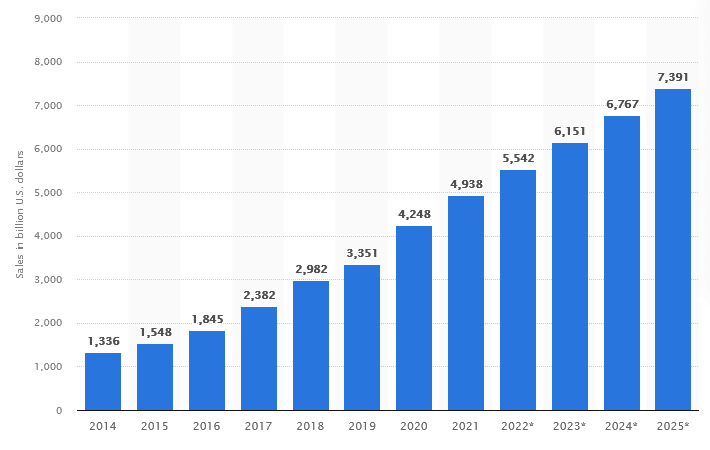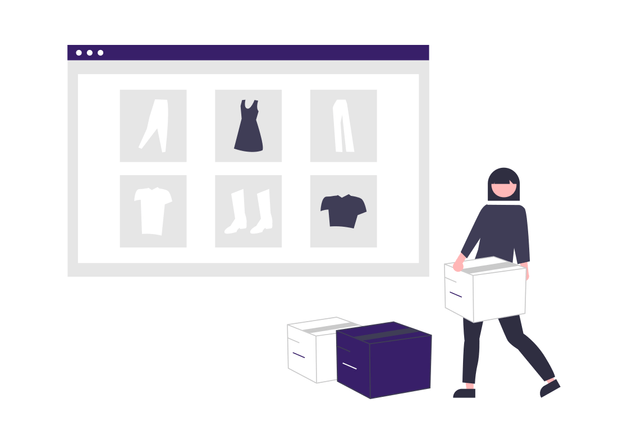The eСommerce this year showed unprecedented growth - experts emphasize a real breakthrough in the minds of customers. More generations joined the eCommerce market, which expanded the product line, logistics, and payment improvements. Thanks to the tools of artificial intelligence, augmented reality, and machine learning, any eCommerce business can become a leader in this competitive market. In this article, we will try to predict eCommerce's nearest future and reveal our thoughts on what may change or remain the same.
What is eCommerce
eCommerce refers to the trade or financial transactions conducted on the Internet. It is any transaction made from an electronic device connected to a network. It covers various types of businesses, from consumer sites or music to the commercial exchange of goods and services between companies. eCommerce is divided into several generally accepted categories. Here are some of the most often types of eCommerce for today:
- C2C (Consumer-to-Consumer) - examples include OLX and eBay, where a person can sell any product even if not an entrepreneur.
- B2B (Business-to-Business). It is characterized by the sale of goods from one business to another. The manufacturer can give the goods to small online stores, where it comes to the end consumer.
- B2C (Business-to-Consumer). It includes cooperation between the online store and the customer, such as purchasing training courses from registered experts, software rental - any retail agreement between legal entities and individuals.
- E2E (Exchange-to-Exchange). The exchange of information or agreements between websites serves as exchanges or brokers that exchange goods and services between businesses. An example can be a transaction from an electronic wallet to a bank card. E2E can be considered a form of B2B.
- G2C (Government-to-Citizens). It includes taxes, utilities, licenses, and so on. Citizens also receive the necessary government information and can do it in electronic form.
The main benefit of eCommerce is the absence of geographical restrictions. Working with logistics companies helps reach a global audience. It is how eCommerce giants such as AliExpress, Alibaba, eBay, Amazon, Zappos, and iTunes work.
eСommerce is much faster, cheaper, and more convenient than all methods of commercializing traditional goods and services. It has also led to the development of e-platforms where suppliers and potential customers converge to trade, which benefits both parties.
It is predicted that eCommerce will record more than $6.5 trillion in sales by 2023, which is 22% of retail sales in the world. And by 2040, the estimates show that 95% of all purchases will be through eCommerce.

The image shows the growth of eCommerce by 50 percent over the next three years, reaching 7.4 trillion dollars by 2025.
Main Trends of the eCommerce Development
90% of decisions to purchase products and services are made online before the customer decides to go to a physical store (according to Statista). Thus, online stores, corporate websites, mobile applications, and other portals are the key to entering the future of eCommerce.
Some trends will remain relevant from previous years, but some are radically changing the market now. These include focusing on user comfort, automating business processes, mobile commerce, brand authenticity, and a new form of trade - the merger of online and offline worlds. Here we collected some of the main trends in eCommerce, which determined the development of the industry, and most likely will not lose relevance next years.
- Mobile eCommerce
In total, 76% of people spend about 3 hours on a smartphone. More and more shoppers regularly use their mobile devices for various tasks, including checking email and paying bills. Using a smartphone for shopping is becoming more comfortable, especially with special applications and "buy now" buttons on social networking platforms.
59% of Google customers said that the ability to shop from mobile devices plays an essential role in deciding which brand or retailer to choose. According to Statista, in 2022, mobile eCommerce will be ahead of other types of digital business.
- Chatbots and real-time customer service
The chatbots help to serve customers without human help. Chatbots can have a text chat on the website, send messages, and highlight special offers. Up to 80% of companies use or plan to use chatbots. They are popular with young shoppers because they often prefer text messages to emails and phone calls.
Chatbot provides direct information for online shoppers who need it. They are convenient for answering simple questions. Chatbots can also automate customer service and offer it in real-time. This software can help customers find specific products or send personalized offers depending on their preferences. The future technology uses simple template algorithms that understand, learn, and act on customer requests. The client will never be disappointed if his issue is resolved at once. It will save customers a lot of time before choosing between similar products and help them improve their search for various products and products and significantly increase sales.
- BNPL options
Buy now, pay later (BNPL) is an ordering option that allows customers to receive the desired goods and pay for them later, similar to credit card work. To enter into a BNPL agreement, the client must pass approval and then pay in installments over some time. Often a service fee is added to the product's price (usually from 2% to 8%). BNPL funding opportunities will continue to grow. According to Mastercard, the market is growing by 20% annually. The IBISWorld report estimates that the BNPL industry will reach $ 1.1 billion by 2025. A survey by PYMNTS and PayPal found that 48% of consumers who prefer the BNPL option will not buy from eCommerce stores without this option.
- Multi-channel retail
Omnichannel Retail is a business model where existing sales channels are fully integrated to offer customers a seamless shopping experience. This model starts with a search engine and leads through an online store and paid content before purchasing. According to a UC Today study, consumers go through six contact points before purchasing. This study also showed that 9 out of 10 consumers want to use omnichannel services.
- Automatization of processes and Customer-Centered Strategy
Automation allows you to solve problems without human help. It can include anything from planning an email to a customer relationship management (CRM) solution, providing data analytics, or using advanced technology to help with hiring. Automation is often discussed in terms of robotics and machine learning. According to a study by ABI Research, by 2025, more than 50,000 warehouses worldwide will include commercial robotics.
Introducing AR and artificial intelligence can improve the quality of your purchases and increase your sales. The technology allows customers to view products and functions through an augmented reality application. AR applications can visualize and reproduce the product for the user to better understand its features. It is very beneficial because customers can try the product they want to buy.
Most online retailers use these robots to solve several problems. Machine learning and artificial intelligence are essential drivers of automation growth. Servion predicts that by 2025, AI will provide 95% of all customer interactions, with consumers expected to prefer interacting with machines rather than people.
- Data analysis and research
Machine learning can be used to predict future sales based on historical data. It is known as Predictive Analytics, which has been around for a long time. This tool helps you get closer to your customers and increase sales. This practice allows you to determine what your customers are likely to buy in the future or choose the product's price that the buyer is expected to pay. The tool will also redirect users through promotions and recommendations. If you can predict the market with artificial intelligence and data analysis, you can easily manage your product price and increase sales.
It’s also possible to use Data Mining - a process of collecting big data and sorting it. It can be all kinds of data, from a competitor's price to a buyer's basket. This data is then checked and tracked, which helps to identify patterns and attitudes to obtain helpful information. This helpful information can identify market trends or develop a marketing strategy to improve sales.
- PWA will improve mobile commerce
Progressive Web Applications (PWA) uses advanced online technology to make the Internet closer to native applications than traditional web pages, especially on a mobile device. These applications are gaining popularity because they provide reliable interaction with the user and have such interaction capabilities as sending push messages and displaying them on the application. It is assumed that the applications will have the same functionality as websites, if not more. Smartphone sales are expected to grow significantly to more than $432 billion in 2023.
- Migration to inline D2C (Direct-to-consumer)
D2C is a model in which the manufacturer avoids intermediaries and distributors and deals directly with the end consumer.
No one knows better about their brand than the product company - the benefits, qualities, and how to convey information to the end-user. Therefore, the company focuses on the advertising development of its sites and invests more money in its social networks, where they can tell as much as possible about their product.
Today, most large companies avoid large marketplaces. For example, Nike has announced that it will no longer place its products on Amazon but focus on developing its own site. And Pepsi has created two sites - one for the sale of snacks and the other - for the sale of groceries.
What’s next
If we speak of tools that help retain and get more customers and grow businesses in the field of online commerce, today it is:
- promotion through social networks;
- contextual and native advertising;
- online webinars, conferences, and other events;
- video content on YouTube and other services;
- digital, performance marketing;
- content marketing (media promotion);
- direct marketing and SEO;
- cooperation with influencers;
- e-mails;
eCommerce business needs a professional, reliable eCommerce solution that helps develop the company globally and offers an optimized payment solution. Read more on how to choose the best eCommerce platforms.
At RabbitPeepers, we can customize your eCommerce platform depending on the size and scale of your business. The RabbitPeepers team can support you with a complex solution to migrate from a tightly coupled monolithic eCommerce platform to a headless system. We keep your backend business flows (e.g., Magento, WooCommerce), enable and adjust REST APIs, build modern and fancy frontend applications and connect them.
Feel interested? Let's talk and see how we can grow your business together and attract your customers.



